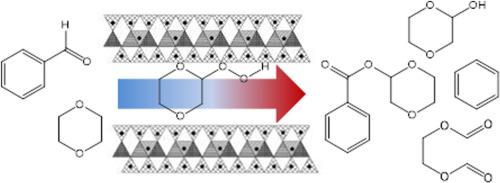Catalysis Today ( IF 5.3 ) Pub Date : 2020-09-03 , DOI: 10.1016/j.cattod.2020.08.032 Daniel Cvejn , Iveta Martausová , Alexandr Martaus , Jan Přech , Ondřej Veselý , Jiří Čejka , Zdenek Lacný , Jan Nedoma , Radek Martínek

|
Transitioning towards green chemistry requires designing sustainable processes to produce both inexpensive and environmentally friendly materials capable of catalyzing complex chemical transformations in fine chemistry. In this context, natural silicate-based catalysts stand out as some of the most promising alternatives, yet vermiculites have been mostly overlooked so far, despite their high potential as clay catalysts with high negative layer charge, high number of exchangeable interlayer cations and high Lewis and Brønsted acidity. Thus, this work reports a previously undescribed and unusual reaction between benzaldehyde and dioxane in the presence of natural and ion-enriched (Al3+, Fe3+, Mg2+, Ni2+, Sn4+) vermiculite catalysts. The effects of different vermiculites on the reaction were assessed both at different activation/calcination temperatures (150 °C, 300 °C and 450 °C) and without activation. Regardless of temperature activation, all vermiculites catalyzed C-C bond cleavage, decarbonylation/ decarboxylation and radical oxidative coupling of benzaldehyde and dioxane, albeit in different yields. Non-activated, natural vermiculite provided the highest benzaldehyde conversion (92 %) and benzaldehyde-based selectivity to the coupling product, 1,4-dioxan-2-yl benzoate (11 %). High benzaldehyde conversion rates were observed also in reactions with aluminum-enriched vermiculite (Al-VMT) activated at 150 °C (84 %), providing 10% selectivity to the coupling product, and with iron (III)-enriched vermiculite (Fe-VMT) (38 % benzaldehyde conversion, 12% selectivity). Catalyst calcination prevented the formation of the 1,4-dioxan-2-yl benzoate while simultaneously enhancing benzaldehyde degradation to benzene. Ultimately, this study shows, for the first time, that vermiculites catalyze radical-oxidative coupling, yielding complex structures such as 1,4-dioxan-2-yl benzoate, which can be used as building blocks in fine chemistry.
中文翻译:

石催化异常的苯甲醛和二恶烷反应性
向绿色化学过渡需要设计可持续的过程,以生产能够催化精细化学中复杂化学转化的廉价且环保的材料。在这种情况下,基于天然硅酸盐的催化剂是最有希望的替代品,尽管mic石具有高负层电荷,高交换性层间阳离子和高路易斯酸的粘土催化剂潜力,但到目前为止,大多数mic石被忽略了。和布朗斯台德酸度。因此,这项工作报告了在天然和富含离子(Al 3+,Fe 3+,Mg 2 +,Ni 2 +,Sn 4+)ver石催化剂。在不同的活化/煅烧温度(150°C,300°C和450°C)和未活化的条件下评估了不同ver石对反应的影响。不管温度如何活化,所有ver石均催化苯甲醛和二恶烷的CC键裂解,脱羰/脱羧和自由基氧化偶联,尽管收率不同。未经活化的天然ver石提供了最高的苯甲醛转化率(92%)和对偶联产物1,4-二恶烷-2-基苯甲酸酯(11%)的基于苯甲醛的选择性。与富铝aluminum石(Al-VMT)在150°C(84%)活化,为偶联产物提供10%的选择性以及富铁(III)ver石(Fe- VMT)(38%苯甲醛转化率,选择性为12%)。催化剂煅烧阻止了1,4-二恶烷-2-基苯甲酸酯的形成,同时增强了苯甲醛降解为苯的能力。最终,这项研究首次表明ver石可催化自由基-氧化偶联,生成复杂的结构,例如1,4-二氧六环-2-基苯甲酸酯,可用作精细化学的基础。


























 京公网安备 11010802027423号
京公网安备 11010802027423号